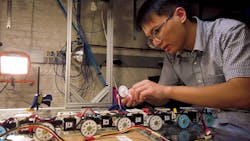By studying how the creatures move, a team of engineers at Johns Hopkins have created a robotic snake that nimbly and stably climbs steps. The research could be used to build search and rescue robots that can move across rough terrain as well as urban obstacles such as steps and curbs.
"We look to these creepy creatures for movement inspiration because they're already so adept at stably scaling obstacles in their day-to-day lives," says Chen Li, a professor of mechanical engineering at Johns Hopkins University. "Hopefully our robot can learn how to bob and weave across surfaces just like snakes."
Previous studies had mainly observed snake movements on flat surfaces, but rarely examined their movement in 3D terrain. These studies ignored for real-life large obstacles snakes encounter, such as rubble and debris, that a search and rescue robot would similarly have to scale.
The team first studied how the kingsnake, a snake that can commonly be found living in deserts and forests, climbed steps in the school’s Terradynamics Lab. The lab melds the fields of engineering, biology, and physics to study animal movements for clues on how to build more mobile and versatile robots.
"King snakes have to regularly travel across boulders and fallen trees; they're the masters of movement and there's much we can learn from them," Li says.
The team ran a series of experiments that changed step height and surface friction to see how snakes contorted their bodies to climb them barriers. They found that snakes partitioned their bodies into three movement sections: a front and rear section that wriggled back and forth on the horizontal steps like a wave, and a middle section that remained stiff to reach the top of the step. The wriggling sections provided stability to keep the snake from tipping over.
As the snakes moved across and up the step, these three body sections traveled down the snake's body towards its tail. As more and more of the snake reached the top of the step, the front body section would get longer and the rear section would get shorter, while the middle section remained the height of the step and held vertically. If the steps got taller or more slippery, the snakes would move more slowly and wriggle their front and rear body less to maintain stability.
The team then designed a robot that copied the snake’s climbing technique. When tested, the robot at first snake had difficulty remaining stable on large steps and often wobbled and flipped over or got stuck on the steps. To overcome this problem, researchers gave the robot a suspension on each body segment. The suspension pressed the wheels against the surface when needed. After this, the robotic snake was more stable and climbed steps as high as 38% of its body length with a nearly 100% success rate. One downside of the added body suspension system, however, was that the robot consumed more electricity.
Compared to robotic snake from other studies, the new one was quicker and more stable than all but one, and even came close to matching the actual snake's speed.
"The animal is still far more superior, but these results are promising for the field of robots that can travel across large obstacles," adds Li.
Next, the team will test and improve the robotic snake for even more complex 3D terrains with more unstructured large obstacles.

